What Massage Types Are Most Effective in Improved Recovery?
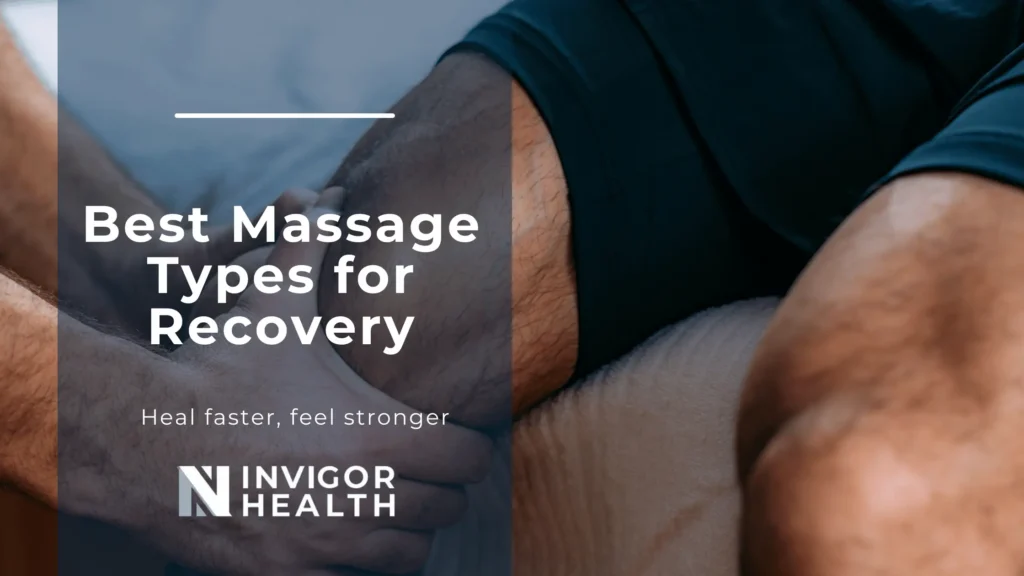
Improved recovery is one of the advantages of massage. Muscle damage can occur for various reasons, the most common of which are injury, surgery, or overuse. The body’s natural healing process kicks in when muscles are injured to mend the damaged structures and fibres. Healing can be slowed for various reasons, resulting in a slower recovery. Swelling, poor circulation, muscle exhaustion, and a build-up of tension are all common reasons for the slow recovery. When healing is slowed, the pain might worsen, exacerbating the injury’s symptoms. This is central for us as a allied health care clinic. Continue reading to learn about massage types on improved recovery and where to find the best physiotherapy in Bondi. What Types of Massage Are Most Effective in Aiding Recovery? Massage therapy comes in a variety of forms that might aid with healing. The following are the most appropriate types of massage to use: Deep Tissue Massage Therapeutic Massage Remedial Massage Deep Tissue Massage Deep tissue massage can aid in the rehabilitation process. The treatment region is massaged with hard pressure during a deep tissue massage. Because it seeks to penetrate deeper into the layers of tissue, deep tissue massage is frequently used to break down adhesions and collagen fibres. Adhesions and collagen fibres are major causes of slow healing and increased discomfort. Adhesions obstruct movement, resulting in muscle tension and stress. Deep tissue massage helps break down adhesions and collagen fibres, allowing more movement and less pain during rehabilitation. Therapeutic Massage A therapeutic massage consists of long, varying-pressure strokes that modify the body’s muscle fibres and tissues to provide a therapeutic impact. A therapeutic massage can help with rehabilitation by lowering tension and improving relaxation. When a person’s recovery is slowed, it might have a psychological impact. Dopamine, endorphin, and serotonin are released during a therapeutic massage, promoting relaxation, pain relief, and increased mood. As a result, improving recovery with therapeutic massage can benefit a person’s physical and mental wellbeing. Remedial Massage Remedial massage therapy in Bondi uses a variety of pressures based on the treatment and the client’s preferences. A remedial massage works on the superficial and deeper layers of the tissues, improving muscle tone and relaxation. Muscle fatigue and weakness are reduced, and tension is reduced through improving muscle condition and enhancing muscle relaxation. A remedial massage also aids in the restoration of damaged muscles by removing restrictions, hence lowering pain and speeding up recovery. What Methods Are Used To Aid Recovery? Massage treatments are used to aid healing in a variety of ways. The following are the most common massage techniques: Effleurage Effleurage is a gentle, pressure-varying massage method. Flattened hands and fingers raise muscle warmth during effleurage by increasing blood flow. Muscle tension that builds up within muscles might hinder recovery. Muscle knots can form due to tension, restricting movement and increasing pain. Muscles are taught to relax and loosen by increasing their temperature through effleurage, which reduces tension. Muscle knots are prevented, and pain is reduced by reducing tension. A reduction in tension and the prevention of muscular knots help in rehabilitation. Kneading Kneading is a common technique for increasing circulation and loosening stiff muscles. It also increases blood flow to and around the treatment region by creating friction between the skin and fingertips. Increased blood flow can aid healing by delivering nutrients and oxygen to the injury site, necessary to repair and renew injured muscle fibres and tissues. Increasing the amount of oxygen and nutrients provided to the injury site might hasten the healing and recovery process. Trigger Pointing Trigger pointing is a technique for breaking down and softening knots by applying little pressure to the trigger points. Blood flow is reduced when pressure is applied, resulting in an ischemic reaction; when pressure is relieved, blood flow increases, which aids in the repair of injured muscle fibres and improves recovery. Conclusion Massage is a fundamental part of the body’s post-exercise or post-injury rehabilitation routine. By alleviating tension, discomfort, and stiffness caused by exercise, massage can help to lessen the risk of injury. Massage can also help with injury rehabilitation by increasing blood flow, which aids in the repair of injured and affected areas. Minor injuries and lesions can be swiftly and efficiently repaired. Massage therapists conduct massage therapy as part of treatment for improved recovery. Invigor Health relieves pain and prepares your body for the future. Contact us if you’re looking for remedial massage therapy in Bondi.
Skeletal Muscle Injuries And What You Need To Know About Them
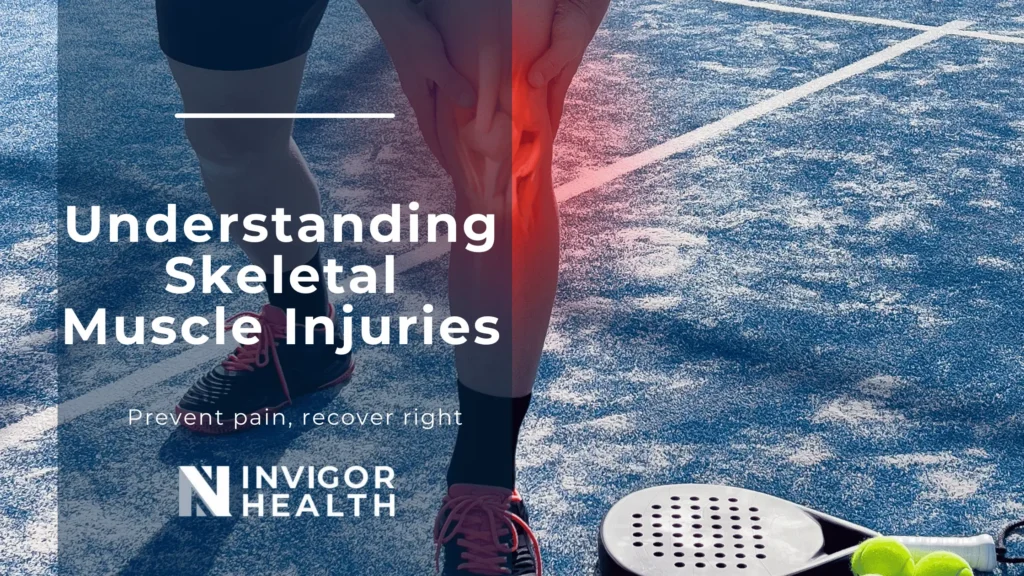
The term “muscle injury” is commonly used to cover a broad range of muscle-related injuries, whether minor or series. Regardless, muscle injuries are never something an athlete wants to face, but unfortunately, the nature of what athletes do generally mean they are at a much higher risk of said injuries. That said, of all traumas in sports medicine, skeletal muscle injuries are the largest, ranging to over half of all sustained injuries. But with us as your allied health care professionals you are in safe hands. Let’s talk more about skeletal muscle injuries to help you understand what they are about: What Is A Skeletal Muscle Injury? A skeletal muscle injury, also known as a “muscle injury”, is what happens when the muscle is damaged, usually from an extreme force being applied to it. They are usually caused by overuse, falls, or sudden movements. Any actions that involve the bones, joints or muscles that could lead to an injury should be avoided during training and checked out by a sports doctor. What Are The Symptoms Of A Skeletal Muscle Injury? The symptoms of a muscle injury are largely dependent on the severity of the injury. As a general rule, if you feel anything more than a very mild pain in your skeletal muscle, you should ask yourself a few questions; Is the pain localised, or is it over a large area? Does the pain feel dull and aching or sharp and burning? Is the pain concentrated in specific areas, or it is a generalised pain? Does the pain radiate to other areas of the body? Is the pain accompanied by any other symptoms? Are there any tingling sensations in the affected area? Does it hurt to move the affected body part? Does it hurt to apply any amount of pressure? Is your affected part more sensitive to the touch? Is the affected part swollen? Is the affected part discoloured? How long has the condition been going on? Once you’ve answered all the questions above, you can be able to pinpoint the type of injury you are dealing with. What Are The Types Of A Skeletal Muscle Injury? There are generally four types of skeletal muscle injuries, each with its own set of symptoms. Sprains A sprain is a stretching or tearing of a ligament where the muscle meets the bone, or the bone meets the bone. Ligaments are very important in the body and are often injured in sports. It is very hard to sprain a muscle, but it is possible. Strains A strain happens when the muscle is torn. This can be caused by overuse, sudden high stress, direct blunt force, extreme muscle movement, and muscle imbalance. Sprains and strains are the most common muscle injuries in sports. Strains are more likely to happen than sprains. Contusions Contusions are bruises caused by bleeding within the muscle. Contusions can happen after a direct impact on the muscle or with a large impact on the bone. Ruptures Ruptures happen when a muscle is ripped or torn off at the joint. This is very rare, but they do happen. This is one of the most severe types of injury and can take an incredibly long time to recover from. Conclusion Skeletal muscle injuries can be very serious if not addressed by a sports doctor immediately. In many ways, prevention is better than cure, and many skeletal muscle injuries could be avoided by taking care of your body and the way you work out. However, when they do occur, treatment is necessary and important to get right. If you need treatment, we highly recommend visiting a physiotherapist to help you heal. With their assistance, you can get on the road to recovery to ensure you’re back in the game as soon as possible! Invigor Health offers physiotherapy that helps fix your ongoing pains and protects you from future injuries for an active, pain-free lifestyle. If you are looking for affordable physiotherapy in Bondi, get in touch with us!
RICE Method: The 4 Crucial Steps for Treating Injuries

If you have experienced spraining your ankle or suffering from any form of strain, your doctor probably recommended the RICE method as an immediate care solution. The RICE method is a self-care strategy in alleviating pain and swelling, consisting of four steps: rest, ice, compression, and elevation. Rest is necessary to prevent further injury, while ice reduces swelling and pain. Compression applies firm pressure to limit the amount of swelling, and elevation keeps the injured area above the heart’s level, improving circulation and easing pain. These various steps have different purposes to help you treat mild injuries before you see your doctor for medical attention. Understanding how each one works together is an excellent step toward a successful recovery. When to Use the RICE Treatment As part of the RICE treatment, your doctor might recommend taking non-steroidal anti-inflammatory drugs like ibuprofen or naproxen, which can be bought over the counter. Before using any of these medications, consult your doctor about your medical history. However, RICE treatment is most useful for mild to moderate injuries like sprains, strains, bruises, other soft tissue injuries. People often sustain sprains by tripping, falling, or through sudden twisting motions. Even repeated movements and lifting heavy objects the wrong way can cause strains. If you are suffering from a more severe condition, it is best to get emergency medical care. This includes severe injuries include deep gashes, burns, serious sprains, head or spinal injuries, or injuries resulting from a car accident. 4 Crucial Steps in the RICE Method Let’s explore the four crucial steps in the RICE method to treat injuries: Step #1: Rest Pain alerts you to something wrong with your body. To recover the fastest, stop all activities and rest as much as possible if you are injured. This will only worsen your injury and prevent recovery. Doctors recommend avoiding putting any weight on an injured body part for at least 24 to 48 hours. Resting also prevents additional bruising from occurring. Step #2: Ice When you have a swelling or a bruise, ice can help to relieve pain. Put an ice pack on the affected area for 20 minutes, three times a day. Don’t put ice onto the skin directly; instead, wrap it in a towel. You can use frozen peas or corn as an alternative if you don’t have any ice. Step #3: Compress To avoid an injury from getting worse, wrap the damaged area. This involves wrapping an elastic bandage around the affected area. Keep it wrapped in place but not too tight. So, make sure you can still move the injured body part even with the bandage. If it’s too tight or decreases the blood flow too much, loosen the bandage or else you may disrupt blood flow to that area and cause more damage to the body. You also must consult a doctor if these symptoms persist. Step #4: Elevation You can alleviate pain, throbbing, and swelling by raising the injured body part above the level of your heart. For example, you can elevate your leg up on a cushion while seated if you have an ankle sprain. Even if you’re not applying ice on the wounded region, it is recommended to keep it elevated whenever possible. Conclusion Keeping to the RICE method can help reduce inflammation and swelling while easing pain and speeding up the healing process of injuries. However, you need to understand the right way to do this self-care strategy to avoid making things worse. Wait for your doctor’s go-signal to use the RICE method before starting. However, if the pain or swelling persists, visit your doctor or a trusted physiotherapist in your area for immediate care. For affordable physiotherapy in Bondi, Invigor Health has you covered. We can boost your body’s function today and for years to come using established treatment techniques. Moreover, our mobile and online physiotherapy services help you stay active, pain-free, and strong to keep doing the things you love. Contact us today!
The Right Things to Do If You’ve Injured Your Hamstring
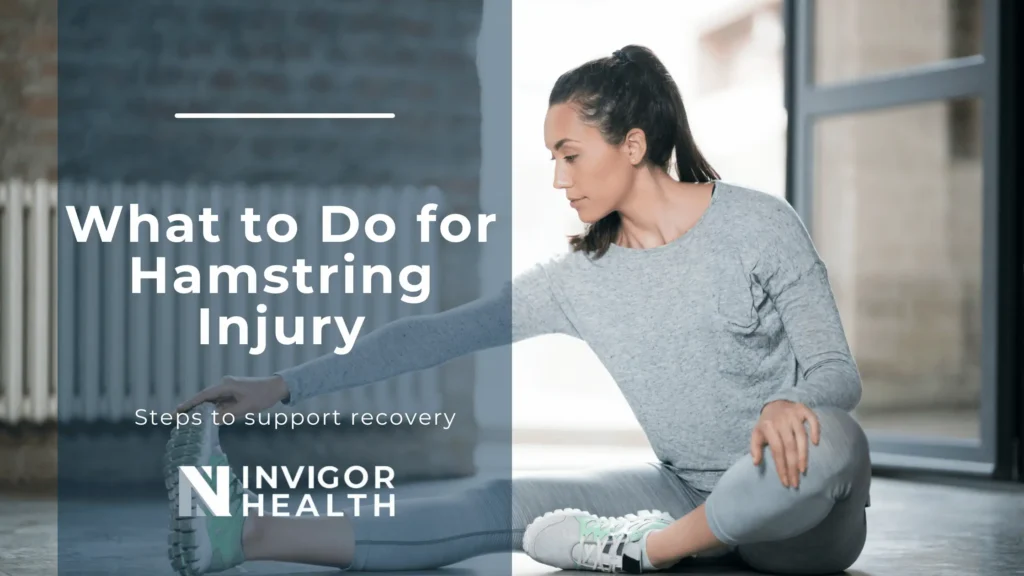
One of the most painful things that a person may experience is an injured hamstring. Besides the discomfort that it may provide, it may also hinder their regular movements. The thing is, its effect may somewhat be mitigated, so as long as the injured person knows how to approach their injury, doing the right things on the first sign of trouble. If it happens to be your first time to experience an injured hamstring, you may want to take note of the following pointers below. 1. Rest The first thing that you should do is to rest. The term “rest” doesn’t really mean that you should just sit back and do nothing. No, you should actually do some light movements, like jogging and walking. They are very effective in helping you reduce your pain and speed up the healing process. Start with a low level of activity, and gradually increase the level as your body adjusts. 2. Compress and Ice Your Hamstring The next thing you should do is buy an ice bag to speed up the healing process. The recommended method is to compress and ice your hamstring area and wrap it up with a towel or a cloth. The ice bag should also be wrapped with towels before you apply it to your hamstring. The application should be done 15 minutes before you take a shower. The icing and compression may help to reduce pain and swelling. 3. Keep Your Hamstring Loose If you can’t avoid doing strenuous activities, you should at least make sure that you keep your hamstring loose. For that purpose, you should stretch it out before doing any activity. If you don’t do that, it is likely that you will not be able to perform your activities well. Instead, it will cause you to feel more pain and may even worsen your injury. 4. Don’t Overtrain If you are injured, the last thing that you should do is to concentrate more on your injury. Instead, you should exercise without any distractions. If you don’t, it is more likely that you will aggravate your injury. 5. Consult Your Doctor If none of the tips above work, and you still feel the pain, then you should immediately consult your doctor. They may refer you to a specialist who can help you handle your injury. When it comes to handling an injured hamstring, you don’t really have to go through the whole process by yourself. For instance, if your doctor finds out that you have an injured hamstring, they can refer you to the appropriate specialist who can make use of the latest research and technology to help you in the healing process. 6. Use the Right Brace If you are looking for ways to help heal your injured hamstring, you need to use the right brace. The thing is that there are a lot of braces that you can use. Some of them are made from natural materials like fabric, while some are made from plastic. There are also those that are made from a combination of both. Conclusion An injured hamstring is one of the most painful things that a person may go through in life. However, you can still minimise the discomfort that you may experience by following the tips above. You can use them to speed up the healing process or even use them to help you deal with the pain. If you want to get the right approach, you need to go see a doctor, as they can help you decide which method is best for your injured hamstring overall. If you are looking for an institution that offers affordable physiotherapist Bondi Junction, look no further than our expertise here at Invigor Health. Our meticulous method aims to focus on our client’s injury, ensuring that it will be tended to with utmost care and attention. Call us today to book your very first physiotherapy session with us.
5 Benefits of Taking Sports Physiology For Tennis Players
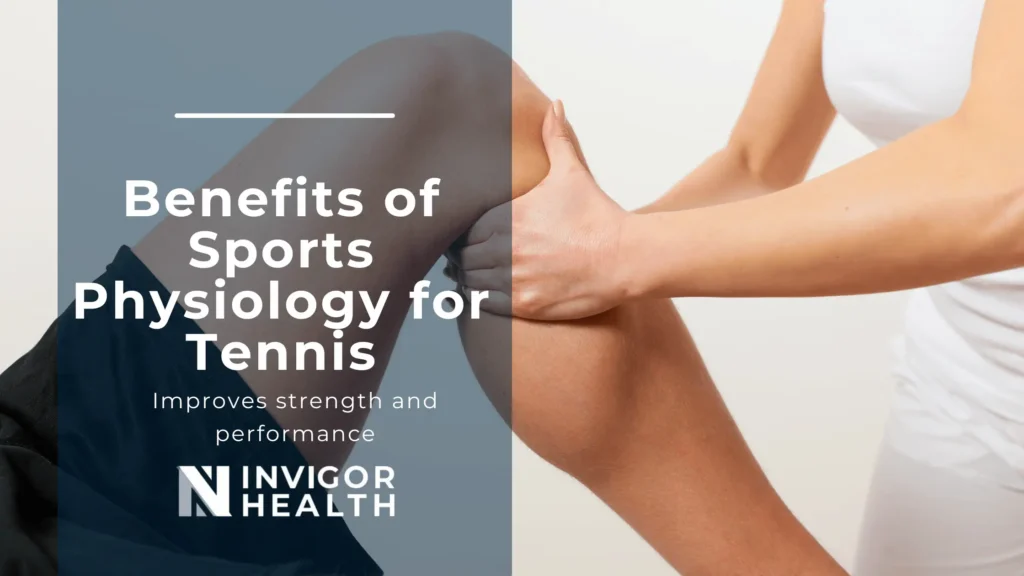
Like most sports, tennis is a high-impact game. The body is often subjected to jarring and cutting motions, making the gameplay challenging and harsh. Meanwhile, the upper body is not free from stress as well. Those who play the sport regularly may experience acute pains, which can turn into chronic pain when not considered. However, the good thing about tennis is that there are many ways to help the body recover from the stress it gives—one of which is sports physiology. But aside from pain relief and temporary rest from the hectic sport, how else do sports physiology help tennis players become their best selves? Here are some examples. 1. Overall Strengthening of the Core Muscles A lot of energy is required to play tennis well. Aside from strength, our bodies also need endurance and flexibility to repeat specific movements, such as keeping balance when moving around the court and hitting the ball. The core muscles are essential for the direction and stability of the body. Aside from reducing back pain, strengthening these muscles will have the following benefits for tennis players. 2. Protects Feet From Trauma The feet are often subjected to repetitive motions when playing tennis. Sometimes, players are forced to land on their feet and then jump into the air to hit the ball. It takes a lot of energy and, if not properly managed, will result in much back, joint, and foot pain. Strengthening the core muscles will help protect the feet from trauma because good core muscles will give the body a strong core. The core muscles will also help with stability and balance. 3. Soothes Sore Muscles The constant movement of the body in tennis may result in sore muscles, which lead to a lot of pain. However, this is not a good thing since the pain may lessen your performance or even worse, the pain may start to linger. If you are experiencing sore muscles, consider those exercises which will ease the pain. Activities using foam rollers are the best ways to help the body recover from soreness. 4. Increases Agility Reasonable body control and agility are significant for every athlete. As you play more and more, your body develops muscle memory which helps you predict the next move of your opponent. Moreover, agility helps players move around the court quickly and easily. Make sure that you include a routine of exercises that will increase your agility, such as improving your body control. 5. Better Body Movements Good body movements are also important for tennis players. In essence, if you are not agile, you can’t keep up with your opponent. As you keep improving your agility, you will be able to make faster shots and moves. Aside from skill, body movements also include core stabilisation. It means that your core muscles should be strong enough to support the entire body and not just the upper part. Conclusion Sports physiology is an essential factor to improve one’s overall health and performance. It also applies to players who need to ensure they are in top physical condition. Aside from physical conditioning, sports physiology is also a great way to improve the overall performance of the body and mind. Its various components, such as fitness and exercise, functional training, injury prevention, stress management, and nutrition management, will help each player achieve their full potential in the sport. Invigor Health offers sports physiotherapy to athletes experiencing various pains and stresses on their bodies. As we offer affordable physiotherapy services in Bondi, we also take time to conduct a health and fitness check to ensure that our patients are at their best before stepping into the field. Contact us or schedule an appointment through our website today and take care of your body from various injuries today.
Exercise Physiologist, Sports Physiotherapist, or a Trainer?

More and more of us embrace exercise, and there are numerous different types to perform. Some turn to dance-based activities, such as Zumba, while others prefer martial arts, such as Kung Fu. Some tone your physique using functional movements, while others emphasise weight training. Regardless of the type of exercise you choose, you should always be careful to avoid suffering from injuries. It might be that you need to seek out a sports physiotherapist, a trainer, or an exercise physiologist. They all have the same goal: to help you get back to performing at your peak level of physical fitness. However, it is helpful to choose the professional who is likely to help you attain that goal in the best way. Let’s look at the differences among the three professions, and you can decide which is the right one for you. Exercise Physiologist vs. Sports Physiotherapist vs. Trainer An exercise physiologist uses scientific methods to train people to improve their performance and prevent injury. They are interested in testing your body, measuring your performance, and using the results to create a training program that suits you. Their goal is to help you manage your fitness, prevent injury, and reach your full performance potential. The sports physiotherapist is most likely to work with an athlete to help them recover after an injury and get back on the field as soon as possible. You can often find them in a clinic, working with patients of all ages and abilities. Lastly, a sports trainer is more likely to offer personal training to match your needs and goals. They are highly trained to help you achieve your personal fitness objectives. Sports Trainers A sports trainer may be the one to help you to achieve your fitness goals, especially when the goal is weight loss, building muscle, or flexibility. They are more likely to assist you in maintaining your level of fitness and reaching your full potential. They will vary their training program to meet your objectives, but they won’t likely help you achieve specific goals unless you seek coaching within a one-on-one setting. Exercise Physiologists An exercise physiologist can help you attain your potential, but they won’t likely help you reach specific goals like weight loss or muscle development. If you are looking for help to lose weight, a sports trainer is likely to be a better choice than an exercise physiologist. However, exercise physiologists may help with general advice and training, especially if you’re looking to hear recommendations from a medical perspective. Sports Physiotherapists A sports physiotherapist can help with injury recovery, and they are also likely to help you reach your general fitness goals. They will help aid you in building muscle, increasing flexibility, and staying fit. However, they are less likely to help you reach specific fitness goals, such as losing weight or building muscle. They will help you get back into the game after an injury, guiding you to regain mobility and strength in the injured area. They will also help you achieve your goals and train safely, too. Conclusion The best way to choose the right specialist for you is to consider your goal. If you wish to build muscle, this is a goal that a sports trainer can best help with. The sports physiotherapist would also be well placed to assist you as long as it is not too early in your recovery from injury. An exercise physiologist is best equipped to provide you with crucial advice regarding your overall physical performance. Do you need affordable physiotherapy in Bondi Junction? Rely on Invigor Health. We offer injury-focused physiotherapy you can trust. Book now.
Differentiating Physical Therapy and Occupational Therapy

Rehabilitative care is a type of treatment that aims to improve or prevent the worsening of an injury, surgery, or illness. This may include physical therapy, occupational therapy, and other treatments such as speech therapy. Yes, you read that right: contrary to popular belief, physical therapy and occupational therapy are not the same thing. Occupational Therapy Also known as OT, occupational therapy essentially zeroes in on fine motor skills and making your home or school environment more optimal for your everyday life. The occupational therapist will also focus on improving your gross motor skills so you can carry out specific day-to-day activities. An occupational therapist may help a stroke survivor re-learn some of their physical and mental skills, such as dressing, eating with utensils, and using the bathroom. An occupational therapist can also rearrange their home to make it safer, such as installing grab bars in the shower. Physical Therapy Physical therapists, also known as PTs, help people improve their movements, mobility, and function by using different physical activities and exercises. A physical therapist might help someone recover from knee replacement surgery by giving him or her a set of exercises and stretches to perform each day. The physical therapist will work directly with the patient to restore their ability to walk normally and achieve a full knee range of motion. This can reduce the pain and swelling that has been troubling the patient. Overall goals for this include, but are not limited to: Decreasing pain Educating you on ways to maintain your overall fitness and functionality Improving or restoring movement Improving or restoring strength Improving or restoring range of motion Preventing your condition from getting worse As such, PT is the usual recommendation when range of motion or movement is affected. Its uses vary widely. Examples of this are: Cancer Hand conditions, such as carpal tunnel syndrome and trigger finger Heart conditions, such as heart failure and recovery after a heart attack Improving mobility after an injury Joint conditions, such as osteoarthritis, rheumatoid arthritis, and ankylosing spondylitis Lung conditions, such as chronic obstructive pulmonary disease (COPD) and cystic fibrosis Neurological conditions, including multiple sclerosis, Parkinson’s disease, and recovery after a stroke Pain management Recovery following a surgical procedure Urinary incontinence Similarities OT and PT have a tendency to get mixed up. That’s likely because of all their similarities. Some of the main ones include: Conditions – Some health conditions have considerable overlap to the point of both therapies being needed all at once. Design – Hands-on care is available through both therapy types. It’s always customized to the particular needs of the patient. Goals – Both OT and PT involve setting goals towards a full recovery. Monitoring – When goals are set for either (or both) PT and OT, monitoring and assessment of progress is vital. Overall purpose – The general aims for both include quality of life improvement, better knowledge and to boost overall functionality. Tasks – Overlap is not uncommon here: OTs can teach exercises or stretches, while PTs zero in on daily activity’s movements including getting in and out of the bathtub as needed. Conclusion Contrary to popular belief, occupational therapy and physical therapy are neither the same thing nor are they interchangeable. Occupational therapy focuses on fine motor skills and optimizing a person’s environment for daily living. Physical therapy deals with a person’s range of motion and mobility. Need a physio in Bondi Junction? Contact Invigor Health today! We offer physiotherapy services meant to keep clients active, fit and pain-free for the long term.
What Should You Do to Cool Down After an Exercise

A cool down is a vital part of your workout. It can last for three to ten minutes and includes stretching or gentle variations of the exercises you did during your training. The purpose of cooling down after exercise is to allow your heart rate and breathing to return to normal and promote relaxation. Completing a cool down when you finish is essential to gain the most benefits from your work. Learn more about the benefits of a recovery period and how you can include one with your next training session. What Is a Cool Down? A cool down is a relaxing period of exercise that promotes recovery. Cool down exercises with low intensity, such as stretching, improve flexibility and circulation. The low resistance and aerobic nature of a cool down decrease the heart rate and breathing rate. Cooling down after a workout helps to reduce muscle soreness. Stretching can also help relieve your muscles of lactic acid buildup during training. You may have heard of high-intensity interval training (HIIT), a popular training method these days. HIIT involves alternating between high-intensity exercise and a cool down. The cool downs in HIIT can include various activities such as stretching and yoga poses. What Are the Benefits of a Cool Down? 1. It allows the heart rate to return to normal. When exercising, your heart rate increases to boost blood flow to your muscles and skin. As your heart rate returns to normal, the blood flow to the muscles decreases and your heart rate decreases. 2. It aids in the recovery of the muscles to allow you to recover from your training session. When you have worked out, your muscles have been through a lot. They have been working hard for you and need some time to recover. Cool down exercises enhance your energy during training by promoting blood flow to the muscles. 3. It prevents injuries. Cool down exercises help to prevent injuries. They help the body to return to a state of relaxation physiologically. If you stop exercising without a cool down, the muscles remain tense, and your joints remain stiff. That is a recipe for injury. 4. It allows you to stretch. Stretching is a vital part of your workout routine. It keeps your muscles loose and allows them to be stretched. 5. It prepares you for your next workout You can ensure a well-rounded workout by providing a cool down after a workout. You promote flexibility and provide recovery for muscles that need it. You also promote increased circulation. 6. It helps you relax The primary purpose of a cool down is to relax the body and calm the mind. It allows the body to rest after the hard work of exercise. A cool down provides a positive feeling to take with you into your next workout. 7. It helps to decrease the development of lactic acid Lactic acid builds up as a product of energy production. When your muscles work, they begin to produce lactic acid as a source of energy. This buildup of lactic acid can make your muscles feel sore and tired. Cool down exercises can decrease the development of lactic acid and thereby reduce muscle soreness. Conclusion A cool down period is not just an unnecessary part of your workout; it is vital to your training routine. Your body requires a period of healing and recovery as well as a period of relaxation. Cooldown exercises can help you achieve all of these things. At Invigor Health, we offer physiotherapy that fixes your pain and future-proofs your body. We provide a whole range of treatments and tools that can help you feel fit, active and pain-free for the long term. If you’re looking for affordable physiotherapy in Bondi Junction, Invigor Health is the perfect place to go. Contact us or book an appointment with us today!
Is Movement Screen Valuable in Predicting Injuries?
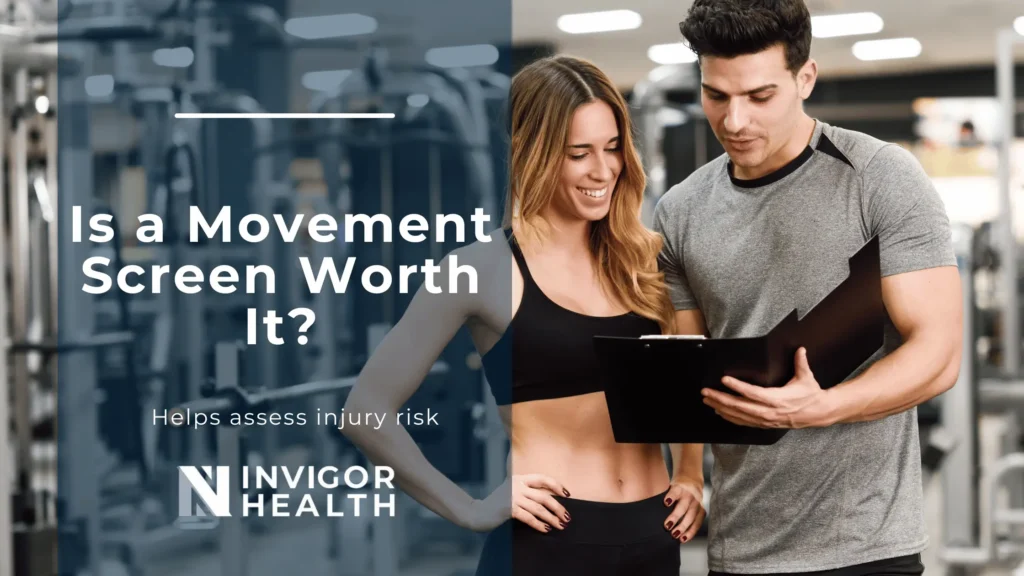
In sports medicine, a functional movement screen in Sydney is very frequent. Every club strives for a competitive advantage to keep its players healthy and on the field. Should we, however, utilise screens to assess harm risk? Understanding why injuries happen necessitates investigating injury risk factors. Identifying risk variables can aid in the development of more effective therapies to reduce injury risk. Risk variables have been studied in the hopes of forecasting an athlete’s injury risk. These investigations frequently involve mobility screenings or performance tests to assess who is at higher risk. While statistical significance between test score and injury risk may be demonstrated in some screening tests, this is the first step in validating screening systems. Roald Bahr elaborated on this concept in the British Journal of Sports Medicine. He emphasises that three research phases are required to validate sports medicine and movement screening. Step 1: Define Cut-Off Values and Identify a Risk Factor Athletes are usually tested before the start of their season. After that, injuries are tracked throughout the season, and risk factors for injury are discovered. Consider the following scenario. One regularly utilised test is the Lower Extremity Functional Test (LEFT). After a lower extremity injury, the LEFT measures an athlete’s preparedness to return to athletics. Brumitt et al. (2013) published a study that aimed to use the LEFT for injury prediction. Before starting each sport’s competitive season, they tested 193 Division III collegiate athletes and followed injuries throughout the season. They discovered that female athletes who completed the test in 118 seconds had 6 times higher risk of developing breast cancer. Many researchers would have concluded that the LEFT can detect athletes in danger of injury at this point, but this is merely the first step. Validation of tests is required, and the authors performed just that. Step 2: Use Multiple Cohorts to Validate the Test The test must be repeated once proven to identify athletes at risk of injury. The same test must be used with the same cut-off criteria to determine the risk of damage in all cohorts that may use the test. Suppose the LEFT test can identify female athletes at a higher risk of injury. In that case, we must retest female athletes across multiple sports and competition levels using the same cut-off criteria. The authors of the original LEFT study conducted a follow-up study to confirm their findings. In the second group of Division III collegiate athletes, they employed identical exams, procedures, and cut-off scores. This time, no correlation between LEFT ratings and injury risk was discovered. Even if the movement screen test has been confirmed before implementing it, one more thing to consider. Step 3: Investigate the Impact of a Screening and Intervention Program A screen’s ultimate purpose is to identify athletes at risk of injury and give them an intervention to lower their risk. If we don’t do anything with the results of a screening test, it isn’t very sensible. This phase shows that a screening and intervention program together is more successful than an intervention program alone. This should be examined in a randomised controlled study with three groups: a control group, a screening and treatment group (in which only high-risk athletes participate), and a group in which all athletes participate. After that, the injury rates are compared between the groups. The screen and intervention group must be more effective than the other two groups for the screen to be relevant. The screen must be sensitive enough to detect high-risk athletes who require intervention while simultaneously distinguishing low-risk athletes who would not profit from the involvement. Conclusion Perhaps an athlete’s injury from the previous season is still bothering them. Movement screening in Sydney could be useful in discovering any deficiencies. For healthy athletes, screenings can also serve as a performance benchmark. If a player is injured, baseline testing might help determine when they can return to play. Ascertain that you can avoid injury while also improving your performance. Invigor Health relieves pain and prepares your body for the future. Make an appointment with us for a functional movement screening in Sydney.
Physiotherapy and How It Helps You Make the Most Out of Life
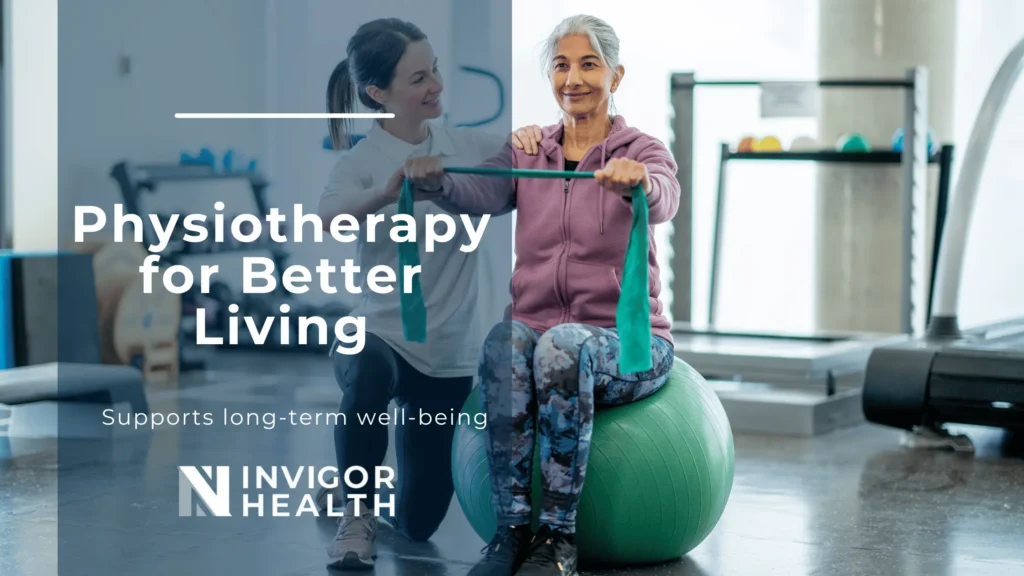
If you’ve never tried physiotherapy before, it can be hard for you to understand the benefits it has to offer. After all, physiotherapy is generally associated with recovery from short-term issues such as injuries and illnesses. However, the fact is that physiotherapy is all about helping individuals get the most out of life, whether it be by treating a short-term or life-long problem. That said, if you’ve got a couple of questions in your mind about physiotherapy, you’re in the right place! Today, let us talk about physiotherapy and how it can help you make the most out of life: What is Physiotherapy? Physiotherapy is a branch of medicine that is concerned with the physical aspects of health. If a person has a physical problem that is preventing them from living their best life, a physiotherapist is the one to call. Physiotherapists are also concerned with physical rehabilitation, which involves the rehabilitation of physically injured or ill patients in order for them to go about their daily lives again. They are also concerned with physical fitness and, as such, will provide patients with exercises and activities that enhance their fitness and wellbeing. It is important to note that while physiotherapists can be found in hospitals, they can also be found in clinics and physiotherapy clinics, in the same way that medical practitioners can be found in hospitals or clinics. What Can A Physiotherapist Treat You For? Seeing a physiotherapist can be beneficial for many different reasons. Here are just some of them: Sports injury rehabilitation Athletes, sports players and anyone who exercises regularly knows that there is a high chance of getting injured. One can be injured during training or even during a match or competition. Physiotherapists are trained to provide treatment for a wide range of injuries, from pulled muscles to sprained ankles and even broken bones. They are also skilled in treating athletes and sports players and will provide them with the best possible treatment to help them return to the field or sport as soon as possible. Injury rehabilitation As mentioned above, physiotherapy is good for treating sports injuries. However, it can also be used to treat all injuries in general, including those that are sustained at the workplace. These injuries can include slipped discs, osteoarthritis, back pain and carpal tunnel syndrome, to name a few. There are cases where such injuries may require surgery, such as a slipped disc. However, a physiotherapist can be consulted to assist with physical rehabilitation and help speed up recovery. Apart from sports injuries or general injury rehabs, physiotherapists can tackle many other things, like post-surgery recovery, arthritis, and a wide range of issues. Regardless, these treatments are all directed at healing the body, allowing to once more enjoy a pain-free life! Conclusion This is just the tip of the iceberg when it comes to understanding what physiotherapy is all about. If you’re interested in finding out more about physiotherapy, why not contact a clinic or physiotherapist in your area for a consultation? They can offer you all the answers you need to your questions, and they will also help you understand whether physiotherapy is right for you! Invigor Health offers physiotherapy treatments to help individuals regain their bodily functions and make the most out of life. If you are looking for affordable physiotherapy in Bondi Junction, get in touch with us today!